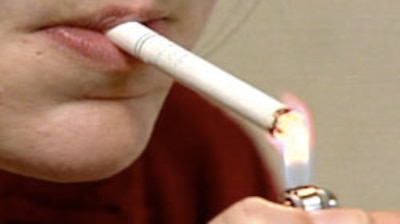
It hardly mattered to Danielle Anders that all Colorado schools are, by law, tobacco-free zones, and have been since 1994. She’d been smoking since she was 11 years old, and she knew where to go on campus to puff in peace.
“Honestly, I never got caught,” said Anders, 18, who is now nearly one-month into her self-imposed regimen for kicking the habit. “People weren’t really watching that much. And teenagers are a lot smarter than people think we are.”
Sneakier, yes. But smarter?
Across the nation, the number of high school smokers – which had increased during the 1990s, then decreased significantly until 2003 – seems to be leveling off, according to a report issued last month by the Centers for Disease Control.
As of 2009, 46.3 percent of teens report ever having smoked, and 19.5 percent say they currently smoke. That’s down from 70.4 and 34.8 percent, respectively, in 1999. In 2003, those numbers had fallen to 58.4 and 21.9. So while the numbers are still going down, the decrease has slowed.
Teen-age smoking in Colorado does appear to have continued a sharp decline, with the percentage of students in grades 6-12 who have ever smoked falling from 31.7 percent in 2006 down to 27.2 percent in 2008, according to a state health department survey of more than 21,000 students at 140 Colorado schools.
What’s more, the number of high school students who currently smoke stood at 11.9 percent, down from 14.6 percent two years earlier.
But not all is clear on the tobacco-free horizon in Colorado.
Budget cuts, underage sales are potent mix
The continued drop-off in teen smoking in the state is due in large measure to Colorado’s concerted effort to fund tobacco prevention and smoking cessation programs for all ages.

In 2005, a statewide cigarette tax increase pumped $27 million a year into such programs, and Colorado was widely viewed as a national leader in anti-smoking efforts.
But last year’s state budget woes meant that anti-smoking budgets got cut. State spending on tobacco prevention efforts will be just $11.1 million in 2010, down from $26.4 million in 2009, which places Colorado 21st among the states, down from ninth.
Even before the budget cuts, ominous smoky signs were in the air:
- The number of middle school smokers remained about the same, 2.7 percent in 2008, up from 2.6 percent in 2006.
- The average number of cigarettes smoked per day did not decrease.
- The percentage of high school smokers who at least tried to quit declined dramatically, from 63.2 percent in 2006 to 51.7 percent in 2008.
- The number of underage smokers who were illegally sold cigarettes when they tried to buy them was up significantly, from 47.9 percent in 2006 to 60.7 percent in 2008.
“Like every other state in the nation, we have a law that requires clerks to check IDs when someone under 30 tries to purchase tobacco,” said Celeste Schoenthaler, director of youth and young adult initiatives for the Colorado Department of Public Health and Environment. “But about half the kids who smoke tell us they’re not being asked for ID.”
When tobacco looks cool, tastes like candy
What’s more, tobacco companies keep rolling out new products that seem especially designed to attract young users. Products like:
- Candy-flavored cigarettes (which are now illegal)
- Nicotine tablets that dissolve in the mouth
- Nicotine-laced water
- Snus, a moist tobacco product similar to snuff, except that it’s swallowed rather than spit out.
- Camel crush, a cigarette that contains a menthol capsule within the filter which, when squeezed, transforms a regular cigarette into a menthol.
“That’s totally targeting teen-agers,” said Anders. “It’s so you can share it with a friend. Adults don’t really share cigarettes because they can afford to smoke their own. But youth will pool their money and share a pack. So if you like menthol and your friend doesn’t, you can each have half the way you like it.”
“And Camel No. 9, a black box with a pink stripe around it – how cool is that?” she asked. “Of course it’s for teenagers. It doesn’t even look like a pack of cigarettes. It could be a pack of gum.”
Anders knows these things because she’s hung out outside the gas stations where these things are sold – usually right next to the candy bars – and either bought them herself or asked friendly adults to buy them for her.
“I’ve always smoked menthols,” she said. “That’s what I like. I never really cared for the strawberry-flavored stuff.”
Anders attended high schools in Broomfield and Thornton before dropping out in January 2009. She later earned her GED and went on to attain a certificate in early childhood education from Front Range Community College.
From teen smoker to teen adviser on health council
Today, she’s the youth representative to a stakeholder group that the health department convened over the summer to begin looking into the problem of illegal tobacco sales, and how to combat them. The group spent time listening to Anders and other teens talk about why and how they smoke, despite the barriers school and health officials have erected.
“Cigarettes are still a huge issue. They pose the greatest danger,” Schoenthaler said. “Our data tell us youth are also using smokeless tobacco and cigars at pretty high rates. And some of these newer products are like starter products because they’re easier to handle than starting with a cigarette.
“But they become addicted to the nicotine. Some of these products contain more nicotine that cigarettes do, and they come in flavors like mint. The health effects of those products are unknown at this point. But the kids tell us you start with those, then move on.”
One project that some school officials are especially excited about is a new web-based tobacco education curriculum entitled Second Chance, which debuted in January but is just now being heavily marketed to school districts. It was developed by the Rocky Mountain Center for Health Promotion and Education, a Lakewood organization, through a grant from the State Tobacco Education and Prevention Partnership.
The curriculum, which is free for schools or courts, targets youngsters who get caught using tobacco on campus, in violation of state law. While punishments may vary at the discretion of the principal, tobacco violations can be grounds for suspension. The Second Chance curriculum, which is self-paced and can take anywhere from one to three hours to complete, is a more palatable option for many offenders.
“We’re trying to keep youth in school, and districts wanted an alternative to suspension,” said Laurie Schneider, the Second Chance project director for RMC. “That’s why this was developed. It’s self-paced and can be accessed from any computer, so a school administrator doesn’t have to sit with a student while they go through the program.”
But school officials can still remotely monitor a student’s progress through the curriculum.
Jeffco among school districts adopting Second Chance
The program, which was designed by curriculum specialists, health educators and graphic designers specifically to address Colorado laws, is interactive. More than simply reminding them of the legal and academic consequences they face if caught using tobacco, youngsters are invited to assess the role tobacco plays in their lives.

They’re invited to weigh the cost of cigarettes against other highly-desired purchases. They’re asked to assess whether quitting smoking would make them more or less popular among peers. They’re reminded that tobacco is the only consumer product that kills if used as directed. And they’re asked to assess the ways tobacco companies lure teens into using their products.
Amy Dillon, Healthy Schools Coordinator for the Jefferson County school district, said the district spent a great deal of time assessing the Second Chance curriculum before deciding to adopt it.
“In a district our size, we wanted to go through all the checks and balances,” she said. “That’s why we haven’t done a big unveiling of this program yet, but we feel like there’s a lot of value in this program, so that students who haven’t been in compliance with the tobacco policy can have a more educational approach as opposed to something punitive.”
During the 2008-09 school year, the last year for which numbers are currently available, 103 Jefferson County students were suspended for tobacco violations, a district spokeswoman said. The year before, there were 131 such suspensions.
Yet nobody likes suspending kids for smoking: “Especially since tobacco is addictive. You just don’t want to suspend them for that,” Schoenthaler said.
‘You don’t think it will happen to you…until it does’
Unfortunately, like other tobacco education programs, the Rocky Mountain Center’s funding was cut this year, so there will be no funding to drive the Second Chance curriculum after Oct. 31. That’s why RMC is pushing the program hard between now and then, to let school officials know that it will continue to exist, even if no more funding becomes available.
“So far, we’ve had great feedback,” Schneider said. “People are saying this is just what they needed. Other non-punitive enforcement strategies are sorely lacking. Second Chance is the only program like this in the country, and we’ve heard from a number of other states who are interested and wanting to explore how it could be modified for use elsewhere.”
Anders, for her part, isn’t sure she would have taken advantage of Second Chance had she been given the choice of that or suspension. She hated school, but she loved smoking.
“But not all youth are like that,” she said. “There are youth out there who do want to change.”
Anders, whose parents and sister all smoke, said stopping has not been easy.
“Honestly, you have to be self-motivated,” she said. “You hear about lung cancer. My grandma has lung cancer. My uncle died of emphysema. You hear about all that, but you don’t think it will happen to you. It’s like getting pregnant. You don’t think it will happen to you … until it does.”
That’s what happened to Anders. Her daughter will turn 2 in December.
“I smoked the whole time I was pregnant,” she said. “I wanted to quit, but some crazy stuff happened. Then my daughter was diagnosed with asthma at 5 months old. I feel responsible for that.”
Anders is now living in a group home for teen-age mothers where smoking is not permitted.
“Since I can’t smoke when I want to now, honestly I don’t enjoy it any more. It’s more of a hassle,” she said. “I didn’t have to use a patch or anything to quit. I had three cigarettes left and I just decided that, when they were gone, I wouldn’t buy any more after that.”
Rebecca Jones can be reached at rjones@ednewscolorado.org.
